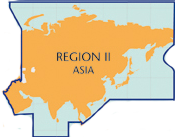WMO Region II (Asia): Lowest Temperature
| Record Value | -67.8°C (-90°F) |
|---|---|
| Date of Record | (a) 5/2/1892, 7/2/1892 (b) 6/2/1933 |
| Geospatial Location | (a) Verkhoyansk, Russia [67°33'N, 133°23'E, elevation 107 m (350 ft)] (b) Oimaykon, Russia [63°28'N, 142°23'E, elevation 800m (2625 ft)] |
References
Climate of the USSR, issue 24, part I, Leningrad, 1956 (From Dr. Meshcherskaya)
Discussion
Considerable controversy has arisen about the record low temperature extremes at Verkhoyansk because of instrument corrections. From Dr. A. Meshcherskaya: "It is accepted that the coldest temperature for the Northern Hemisphere occurred in Verkhoyansk, Russia on 6 and 7, 1892. But in those days the temperature was measured by spirit thermometer, which is less accurate than a mercury thermometer. The spirit is the evaporating liquid, therefore measurement by spirit thermometers must be corrected (usually the correction is positive, being about 0.2°C, but is not so simple). According to "Climate of the USSR, issue 24, part I, Leningrad, 1956," the coldest temperature (-67.7°C) occurred in Oimaykon on 6 February 1933. It is necessary to have in view that winters in East Siberia during the 20th century have become about 3°C warmer.
By the opinion of the majority of Russian climatologists, the coldest place in the Northern Hemisphere is Oimyakon. Since the 30-th years of 20th century, almost every winter Oimaykon is colder than Verkhoyansk. The mean difference of minimum winter (December-February) temperature in Verkhoyanskand in Oimyakon for 43 coupled years in 20th is 2.3°C.
Additional Images
![Regional Satellite Images of Verkhoyansk, Russia and Oimyakon, Russia Oimaykon, Russia [6e°28N, 142°23'24.00'E, elevation 107 m (350 ft)]](/sites/default/files/2024-02/oimyakon1.jpg)
![Regional Satellite Images of Verkhoyansk, Russia and Oimyakon, Russia Oimaykon, Russia [6e°28N, 142°23'24.00'E, elevation 107 m (350 ft)]](/sites/default/files/2024-02/oimyakon2.jpg)

WMO Region II (Asia)
![Closeup Satellite Images of Verkhoyansk, Russia and Oimyakon, Russia Verkhoyansk, Russia [67°33'N, 133°23'E, elevation 107 m (350 ft)]](/sites/default/files/2024-02/verhoyansk1.jpg)
Closeup Satellite Images of Verkhoyansk, Russia and Oimyakon, Russia
![Closeup Satellite Images of Verkhoyansk, Russia and Oimyakon, Russia Verkhoyansk, Russia [67°33'N, 133°23'E, elevation 107 m (350 ft)]](/sites/default/files/2024-02/verhoyansk2.jpg)
Closeup Satellite Images of Verkhoyansk, Russia and Oimyakon, Russia